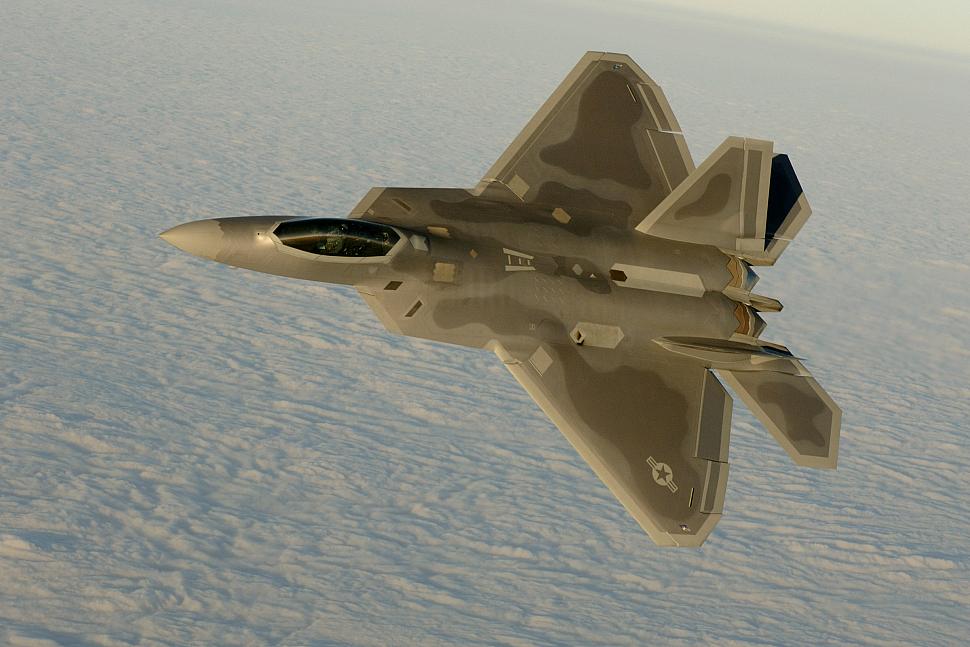Fighter Jet News
F-22 Raptor News
F-22 team successfully completes first aircraft service-life fatigue testing
May 30, 2002 (by
Jeff Hollenbeck) -
The Lockheed Martin-led F-22 Raptor team surpassed another significant milestone in May with the successful completion of "first service-life" fatigue testing using a production quality, non-flyable Raptor airframe in a special ground-based laboratory located here.
Completed on May 17, this testing is required for the program to receive its Lot 3 production contract for 23 additional Raptors from the Pentagon later this year.
The F-22 Raptor air dominance fighter is built by Lockheed Martin Aeronautics Co. in partnership with Boeing.
"Successful completion of the first service-life of fatigue testing - the equivalent of 8,000 simulated flight hours - gives great confidence that the F-22 Raptor will provide the Air Force with a durable and rugged airframe capable of meeting the warfighter's needs," said Bob Rearden, Lockheed Martin Aeronautics vice president and F-22 program general manager. "I want to acknowledge the hard work and dedication of the many engineers, mechanics, instrumentation technicians, and inspectors here and around the country who have kept this test running around the clock, and thank all others involved who helped make this test a tremendous success."
The airframe fatigue test is designed to demonstrate the F-22's durability over its planned service life of 20 years, or 8,000 flying hours. The test was conducted on Raptor 4000, one of two, non-flyable full-scale test airframes located at Lockheed Martin Aeronautics facility in Marietta, Ga. During the lifetime fatigue test, Raptor 4000 was stressed by nearly 200 hydraulic rams designed to simulate loads a flying F-22 might expect during operational use. Each lifetime equivalent of testing involves more than 1.2 million stress events simulating aircraft maneuvers up to and including 9-g events. To enhance the fidelity of the testing, Raptor 4000's fuel tanks, inlet ducts, and cockpit were pressurized to remain consistent with the F-22's expected flight profiles.
Fatigue testing of Aircraft 4000 will continue and is scheduled to simulate a total of two lifetimes of fatigue evaluation- the equivalent of 16,000 flight hours. The test article will be evaluated for damage tolerance involving up to another two lifetimes of test exposure. As a result, data accumulated from these tests could support long-term efforts to extend the F-22's usage beyond its intended 20-year service.
The F-22 Raptor air dominance fighter is built by Lockheed Martin Aeronautics Co. in partnership with Boeing.
"Successful completion of the first service-life of fatigue testing - the equivalent of 8,000 simulated flight hours - gives great confidence that the F-22 Raptor will provide the Air Force with a durable and rugged airframe capable of meeting the warfighter's needs," said Bob Rearden, Lockheed Martin Aeronautics vice president and F-22 program general manager. "I want to acknowledge the hard work and dedication of the many engineers, mechanics, instrumentation technicians, and inspectors here and around the country who have kept this test running around the clock, and thank all others involved who helped make this test a tremendous success."
The airframe fatigue test is designed to demonstrate the F-22's durability over its planned service life of 20 years, or 8,000 flying hours. The test was conducted on Raptor 4000, one of two, non-flyable full-scale test airframes located at Lockheed Martin Aeronautics facility in Marietta, Ga. During the lifetime fatigue test, Raptor 4000 was stressed by nearly 200 hydraulic rams designed to simulate loads a flying F-22 might expect during operational use. Each lifetime equivalent of testing involves more than 1.2 million stress events simulating aircraft maneuvers up to and including 9-g events. To enhance the fidelity of the testing, Raptor 4000's fuel tanks, inlet ducts, and cockpit were pressurized to remain consistent with the F-22's expected flight profiles.
Fatigue testing of Aircraft 4000 will continue and is scheduled to simulate a total of two lifetimes of fatigue evaluation- the equivalent of 16,000 flight hours. The test article will be evaluated for damage tolerance involving up to another two lifetimes of test exposure. As a result, data accumulated from these tests could support long-term efforts to extend the F-22's usage beyond its intended 20-year service.
Related articles:
Forum discussion:
Tags
Forum discussion:
- 421st Tactical Fighter Squadron / Fighter Squadron ( 8 replies)
Tags

